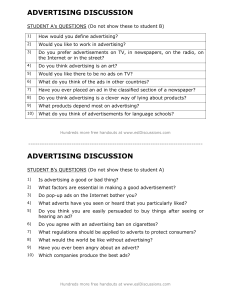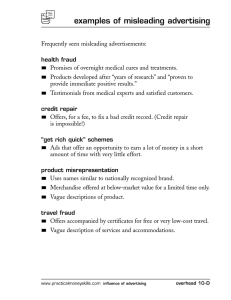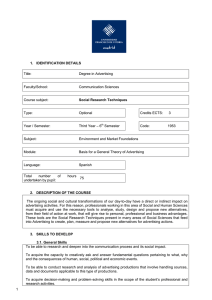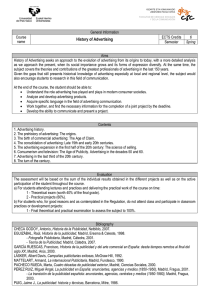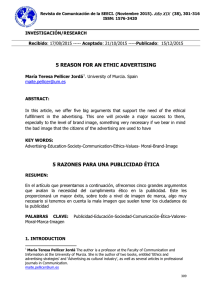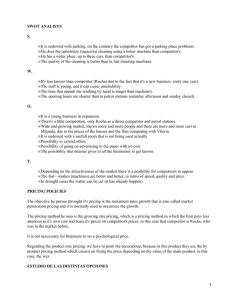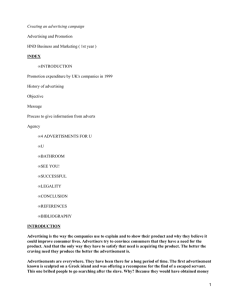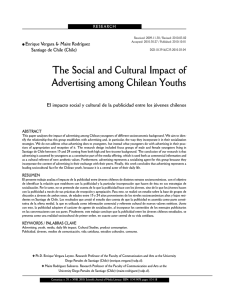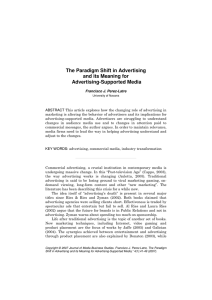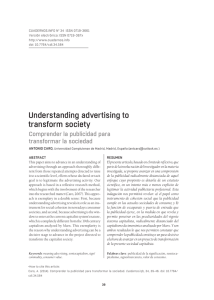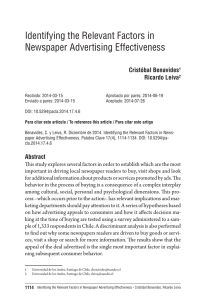ecological dimensions of advertising
Anuncio
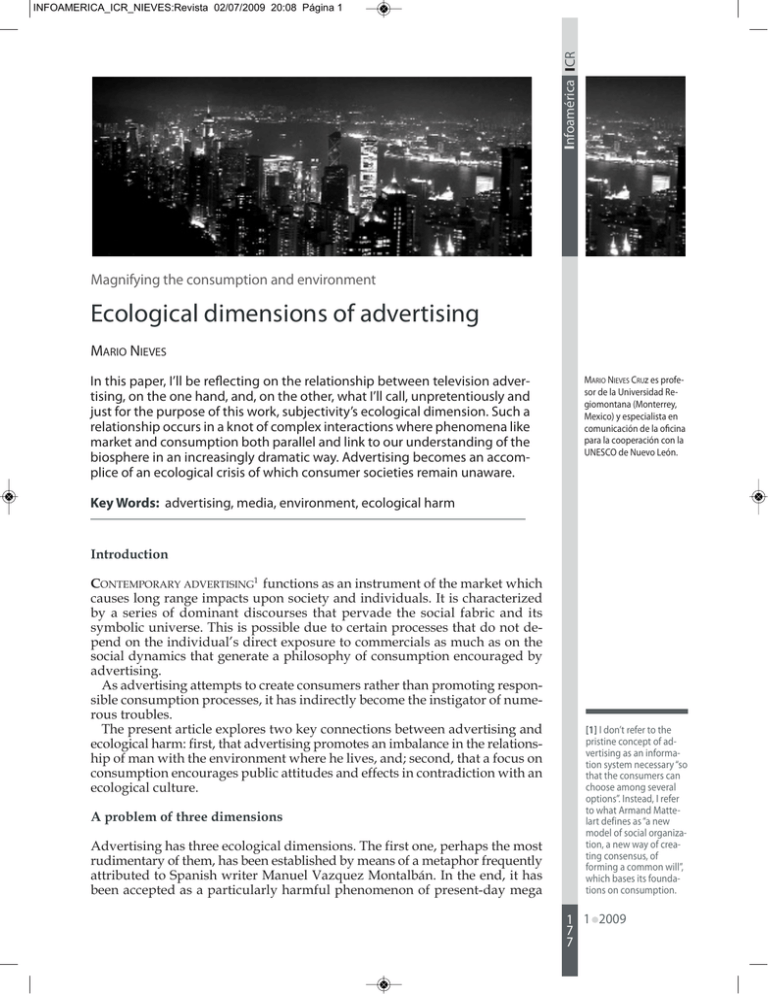
Infoamérica ICr INFOAMERICA_ICR_NIEVES:Revista 02/07/2009 20:08 Página 1 Magnifying the consumption and environment ecological dimensions of advertising Mario Nieves in this paper, i’ll be reflecting on the relationship between television advertising, on the one hand, and, on the other, what i’ll call, unpretentiously and just for the purpose of this work, subjectivity’s ecological dimension. such a relationship occurs in a knot of complex interactions where phenomena like market and consumption both parallel and link to our understanding of the biosphere in an increasingly dramatic way. advertising becomes an accomplice of an ecological crisis of which consumer societies remain unaware. Mario Nieves Cruz es profesor de la universidad regiomontana (Monterrey, Mexico) y especialista en comunicación de la oficina para la cooperación con la uNesCo de Nuevo León. Key Words: advertising, media, environment, ecological harm Introduction Contemporary advertising1 functions as an instrument of the market which causes long range impacts upon society and individuals. it is characterized by a series of dominant discourses that pervade the social fabric and its symbolic universe. this is possible due to certain processes that do not depend on the individual’s direct exposure to commercials as much as on the social dynamics that generate a philosophy of consumption encouraged by advertising. as advertising attempts to create consumers rather than promoting responsible consumption processes, it has indirectly become the instigator of numerous troubles. the present article explores two key connections between advertising and ecological harm: first, that advertising promotes an imbalance in the relationship of man with the environment where he lives, and; second, that a focus on consumption encourages public attitudes and effects in contradiction with an ecological culture. A problem of three dimensions advertising has three ecological dimensions. the first one, perhaps the most rudimentary of them, has been established by means of a metaphor frequently attributed to spanish writer manuel vazquez montalbán. in the end, it has been accepted as a particularly harmful phenomenon of present-day mega [1] i don’t refer to the pristine concept of advertising as an information system necessary “so that the consumers can choose among several options”. instead, i refer to what armand Mattelart defines as “a new model of social organization, a new way of creating consensus, of forming a common will”, which bases its foundations on consumption. 1 1 2009 7 7 ICr INFOAMERICA_ICR_NIEVES:Revista 02/07/2009 20:08 Página 2 Mario Nieves cities. i’m referring to the trite concept of visual pollution, a term inappropriately assumed as the ecological effect par excellence of advertising. the metaphor is now a category, an academic concept, a scientific issue and has been incorporated, as it will be seen further on, in numerous legal texts. the phrase had not been invented yet when, in 1963, david ogilvy confessed that in his personal life, he felt a passion for landscapes and he had never seen posters beautify any of them. the american publicist said that when an environment is beautiful, man shows his vilest face the moment he places a billboard in its midst. almost half a century before, in what could be considered a prelude to this problem, Coca-Cola Company painted almost two and a half million square meters of walls and planted billboards along almost a million kilometers of roads in the United states, “enough to turn this into a nightmare for the consumer.” that nightmare is now called visual pollution. it has been defined as “the excess of advertisements on the open public space which deteriorates the urban view and turns it chaotic”. a very descriptive definition by daniel Wolkowicz highlights the nightmare’s nuances: “a texture that acts upon urban architecture, which is replaced and is recreated in new communicational sceneries. (…) a kind of visual sampler, without any regulation, which affects our assimilation capability and conditions the esthetics of our public spaces. marquees, gigantic pictures, ads on overpasses, posters and signboards make up a particularly invasive view, where citizens are exposed, without any consideration or respect, to a constant visual saturation. (…) the street is the field where the visual battle is held, there are no possible negotiations…” i allow myself to disagree with Wolkowicz on one aspect. it’s not only in the streets where this conflict is to be found. as is well known, what started on building walls has overflowed into closed spaces, particularly inside the big malls or shopping squares, those gigantic places which ritzer called consumer cathedrals, where millions of people gather every day. perhaps the concept of visual pollution is inadequate when what we are really experiencing is environmental pollution, meaning a “series of harmful effects on the biosphere caused by human activity”. to speak of environmental pollution allows us to ‘see’ the contaminating effects of advertising found in many different fields of vision, among them television and the internet. such an expanded semantic perspective would also allow us to legally question practices such as the unscrupulous pruning of trees carried out for the sake of building new panoramic billboards that has engendered alarm in many cities. For example, the Buenos aires Constitution deals with the “preservation of its inhabitants’ visual quality” and states that the Buenos aires citizens have the right to walk in and inhabit “areas free from visual and noise pollution”. advertising’s second ecological dimension is more subjective and relates to the ways through which meaning is produced. the production of meanings is essential, according to psychologist gonzalez rey, as both a shaping and a shaped moment of subjectivity. meaning production is defined by a complex articulation of emotions, symbolic processes and senses; it adopts variable forms and is context dependent. the impact of contemporary television advertising must be understood through this perspective. While it is through the individual where the meanings of the neoliberal discourse are ultimately expressed, it is through the social imagery of advertising where they develop. every single social space is a living space for the production of meaning. the consumerist craving ge- 1 2009 1 7 8 ICr INFOAMERICA_ICR_NIEVES:Revista 02/07/2009 20:08 Página 3 ecological Dimensions of advertising nerated by contemporary metropolises defines how billions of human beings’ view their world. Because of this, we watch as people pursue happiness in places and in ways that it doesn’t exist. the success of this consumerist craving seems to persuade every one –as Lipovestky suggests– that advertising expects for itself “a rose-colored future”. this optimism is evidenced by the ever growing amount of publicity expenses, and by the invasion –seemingly unrestrained– of all human spaces, both objective and subjective with advertising. the techniques of advertising expand as well. the development of new approaches and research that feed them grows as well. the concept of an “advertising science”, financed by corporations with a swarm of outstanding scientists working for them, progressively occupies larger publishing and academic spaces. students learn advertising from best seller books that show how consumers think and how to proceed in order to break any vestige of common sense in their shopping. once subjectivity has been defied, the assault on the unconscious is the next goal for market researchers. although mcLuhan advanced very well known remarks in this sense, few have articulated this in such a disturbing manner as gerald Zaltman some thirty years after: “Let’s figure out a filter that allows us to see, in color, the variations of heat intensity in objects. through that filter, a loaf of bread just baked that has been cooling down for fifteen minutes looks like a rainbow, because different portions of the bread loose heat in a different rate. the loaf keeps its usual shape and texture, but it has a more attractive aspect as seen through the filter. now let’s imagine such a filter applied to the buyers’ unconscious thoughts. it will show more colors than any fireworks show could dream of producing. these new colors represent the treasures hidden in the mind’s darkness, in the cognitive unconscious. Learning to spot and employ those colors is the main border territory that companies should explore when searching for new information about the consumer’s thought and behavior.” A negative way the impact of consumerism –and of advertising, one of its vehicles– on millions of individuals must be bewildering. as philosopher michel serres used to say, these people choose to keep on with a life of parasites –our present day state–, condemning the planet where they live and get fed to death, “without perceiving that in the end they condemn themselves to disappearing”. the third ecological dimension of advertising is best seen as a contradiction. on one side, the stimulating impact of advertising on consumption ultimately affects the environment in a negative way. on another side, the goal of advertising is to show ways of satisfying human needs (of which a healthy environment would be central). in other words, in the name of satistifying human needs, advertising disregards the calamities that threaten the consumers’ very existence. the data related to this are alarming: in the same manner that publicity investments steadily grow (for selling, among other things and at the highest costs, bottled water), in a great number of countries the public budget devoted to satisfy the people’s needs is cut down. this happens in a world where over a billion people lack access to drinking water and some 40 thousand children die daily of thirst. in 2008, the United states devoted nearly 7 billion dollars to fight climate change. at the same time, they invest more than 200 billion dollars a year in advertising. Car production keeps rising and it’s expected that in the next 1 1 2009 7 9 ICr INFOAMERICA_ICR_NIEVES:Revista 02/07/2009 20:08 Página 4 Mario Nieves twenty years 600 million vehicles will be running over the globe – effectively counteracting any hope raised by the billions of trees recently planted all over the world as a contribution to deter the climate change. some countries like Brazil, Colombia, ecuador and the United states, spend in commercial advertising sums which amount to over one percent of their respective gdp. according to experts, an investment equivalent to one percent of the world’s gdp would suffice to curb climate change. Brazil invests more than six billion dollars a year in commercial advertising. that amount of money would be enough to finance a world campaign to eradicate illiteracy. general motors Corporation is the United states’ second largest company in terms of advertising dollars spent, with a publicity investment that surpasses four billion dollars a year. this exemplifies how automobile production and buying grow with the support of advertising. this happens not only in large industrialized nations but in countries like China or india, as well, where increases up to 20 percent a year are registered. Contrast this with statistics revealing that atmospheric pollution generated by each private car running is fifteen times higher than public transportation emission. “a society haunted by the frenzy to produce more in order to consume more –wrote mexican writer octavio paz–, tends to convert ideas, feelings, art, love, friendship and even people themselves into consumer goods. everything turns into something that is bought, used and disposed of. no society has produced so much waste before ours.” the mexican author’s concern can be accounted for with just a handful of data: in the whole world, every year over 500 million cellular phones are thrown away. the manufacture of each one of them generates 75 kilograms of waste. the whole process involved in the making of a single gold ring, from the moment the mineral is dug from the ground until its final turning into a fine jewel, produces two tons of waste. meanwhile the production of a personal computer brings about a ton and a half of garbage. each day, north american people dump 49 million disposable diapers. Ecological contradiction Let’s go back to gonzalez rey’s idea that every social space is alive in producing meaning. the following data reveal the weight of advertising in the present day world for the purpose of materializing the largest consumer project ever attempted in mankind’s history: Car use by indians grows at a yearly rate of 20 percent. this contradicts the ecological outlook advocated by mahatma gandhi who opposed the idea that a free india would intend to be like great Britain, because, he argued, if “great Britain needed half the earth’s resources to become what it is, how many planets then would india require?” the second half of the last century witnessed a remarkable increase of air traffic, which rose by a hundredfold. the printing of sunday newspapers in the United states devours such a quantity of paper that production demands the cutting of hundreds of thousands of trees. a citizen of the western world, before turning twenty years old, has been exposed to the uninterrupted bombardment of a third of a million advertising announcements. since 1950, the world has tripled its water consumption, quintupled fuel use, increased meat expenditure more than five times and quadrupled carbon dioxide emissions. in the same period, world advertising expenses multiplied by ten, automobiles, which numbered 53 million in 1950, grew to 700 million in 2007. all this frenzy for consumption has been accompanied and stimulated by 1 2009 1 8 0 ICr INFOAMERICA_ICR_NIEVES:Revista 02/07/2009 20:08 Página 5 ecological Dimensions of advertising advertising, frenzied as well, without noticing that it implies, like Jeróme Bindê said, a “state of war against nature, the war against environment.” such a situation has no way out other than the one suggested by michel serres: “we must decide on peace among ourselves in order to safeguard the world and on peace with the world in order to safeguard ourselves.” How advertising operates under these circumstances there is a space where society inscribes its experiences, builds the lives it hopes to live, and shares its fragile subjectivity: imagination. it’s pointless commenting that this space is overflowed with the symbolic production of cultural industries, including the advertising avalanche. these are the circumstances that impregnate the work of imagination, as put by anthropologist appadurai, for whom imagery is a central constituent element of modern subjectivity. From my point of view, there is a link between imagination and social life and it is a link increasingly determined by advertising devices. advertising constrains our imagination and keeps an accomplished life purposefully just out of reach. Further, television advertising widens its spheres of influence when it’s not seen as the sum total of discrete elements (the ads themselves) and is instead understood as discourse. seen from this perspective, its influence on society’s imagery can be understood. it must not be forgotten that the outcome of advertising does not necessarily depend on the encounter between message and viewer. in the light of new theoretical approaches, where anthropologists, sociologists, psychologists and communication experts coincide, media’s production of symbols influences the work of imagination. this achieves visible shape in the very practices of individuals who develop the capability of functioning like agents. according to this, some consumers turn into vehicles of those consumption practices to which they’ve been attracted by ads. Three categories for the study of television advertising effects 1. Mediated diaspora nature counts on surprising ways to scatter the seeds that perpetuate over 250 thousand plant species on the planet. Unfit to move, plants entrust their seeds to certain agents (winds, water flows, birds or other animals, man) that transport them to other places where they spring in new plants. the power, reach and penetration of contemporary advertising are based on a comparable logic, just as it is boosted by complex devices and by human subjectivity. i define this phenomenon as “mediated diaspora”. the advertising message needs agents. Without agents diaspora doesn’t occur and without diaspora there are no practices of mass consumption. the advertising agent par excellence is the consumer. this issue is extremely revealing. the relationship between the seed and any of its agents is arbitrary, accidental and ephemeral. However, the relationship between man and the symbolic content to which he lends himself as an agent is dynamic, complex, multidimensional, causal and intersubjective. man gives meaning to symbols that concretize his everyday life and which he shares in various ways with others. man carries within himself many different announcements. as he takes part in the dynamics of consumption, unleashed by the advertising discourse, and functions as its agent, he doesn’t detach from that discourse like the wind does with the seed. instead, he ap- 1 1 2009 8 1 ICr INFOAMERICA_ICR_NIEVES:Revista 02/07/2009 20:08 Página 6 Mario Nieves propriates, transmits and shares it in intersubjective relationships which are not linear but netlike, complex and of exponential growth. there’s also diaspora when the experience of consumption, the ideas about it or the reflections over determined practices leading to consumption, penetrate the dialogic relations and, through them, they feed the daily flows of social discourse. there’s mediated diaspora when the individuals objectify certain symbolic contents of advertising, thus becoming agents of such objects and, by extension, of the dialog that magnifies its consumption. all this occurs through a netlike process that grows exponentially until developing a market of considerable magnitude. 2. Cognitive replica the term cognitive replica is applied here to a complex effect associated with the production of symbols by contemporary advertising. this advertising tends to restrict knowledge to an impoverishing version of the individual’s world where consumption and its associated processes occupy a relatively dominant role. the limits and range of the replica seem to be determined by the link between a consumerist attitude of certain social groups and the internalization of the predominant models of advertising discourse, which are later materialized in those people’s life projects. this way, knowledge tends to structure itself as an accumulation of experiences triggered by advertising. the individual’s cognitive development, under determined circumstances, is partly shaped as a replica of the symbolic universe after which his knowledge, language, attitude and sensitivity are modelled. the results of the present study lead us to no other conclusion but realizing the paramount role of television advertising in peoples’ creation of imaginary worlds rather than in their rigorous perception of the real world where they live. When establishing the place of advertising devices in the building of social or individual identity, german philosopher Wolfgang Haug proposed the concept of “merchandise esthetics”. this is intended, in mattelart’s, to emphasize how imaginary spaces are organized around consumed or desired objects. the cognitive replica is an effect characterized by being alienating, selective and regressive. it operates in three dimensions: 1. on the individual’s mind. this constrains his imagery to the poor and ephemeral knowledge repertoire supplied by his intense relationship with the world of consumption. 2. on the individual’s relationship with external reality. Upon the latter he imposes his world outlook achieved through his experiences, getting enclosed in it and operating within the points of reference at his disposal. 3. on interpersonal relations. these form netlike dialogic structures that give consumption an unprecedented dimension. 3. Dominant sense the avalanche of messages to which a televiewer is submitted reaches such proportions that it has become a problem for scientists. science knows that more than eighty people out of a hundred are unable to remember many details from a commercial they have just watched on tv. it’s also known that barely one out of four ads can be recalled a day after being viewed. 1 2009 1 8 2 ICr INFOAMERICA_ICR_NIEVES:Revista 02/07/2009 20:08 Página 7 ecological Dimensions of advertising Contemporary advertising relies largely on goals where the product is amply exceeded by the way of life. From here derives its eagerness to build meanings increasingly more coherent with the main purpose of encouraging an indulgent life, the only way of securing captive consumers. the economic and social background of the present complex moment intervenes in the configuration of the relationships among advertising, life style and consumption. the main vehicle of this consumerist aesthetics, of this push towards fascination, of this extolling of appearance while despising substance, is advertising. the purpose of advertising does not consist any longer of just selling a product. it now attempts to develop, in unprecedented scales, mass strategies intended to boost a consumerist culture. For this, it focuses on producing meanings which keep the individual a captive of its offer and under control of its strategies. By way of some conclusions: some words on Earth Few topics occupy such a central place in man’s history as that of earth. in mankind history, as ecologist enrique Leff has already said, “all knowledge, all learning about the world and its things, has been conditioned by the geographical, ecological and cultural context in which a social formation appears and develops. the production practices, depending on the environment and the social structure of the various cultures, have engendered forms of perception as well as specific techniques for the social appropriation of nature and the transformation of the environment.” the flourishing of human culture has been possible under the protection of earth’s generosity. there’s no civilization, culture or social act on the fringe of nature. the cave walls served as the first canvas on which man reproduced an image of himself and of the living beings around him. it was from nature, as well, that he produced his first brush and his first pigments. Knowledge was first stored by way of inscriptions carved in the stones. Later it was marked into clay tablets and afterwards over thin sheets made out of macerated papyrus stems. all egypt’s greatness –even all its mystery– came to be possible thanks to the nile river. egypt, paraphrasing Herodotus, is a gift from nature. as also were Babylon, mesopotamia and india. something disturbing happens nowadays, since it’s not possible any longer to state whether today’s mega-cities are a gift or a challenge. in contrast with a splendid past when man used to consider himself a part of earth, not its owner, at present ecological devastation, environmental deterioration and the worsening of quality of life for most people appear like a distinguishing token of the economic rationale upon which modern civilization has been raised. on the unbridled run towards economic growth nature has been hurt, subverting cultural identities and undermining the basis for the planet’s ecological sustainability. the Earth Charter was written in a moment when changes concerning how we think and live are needed. it challenges us to think about our values and search for a path that leads us away from an uncertain destiny. it makes a call for us to find a common space amid our diversity and to acknowledge a new ethical outlook which is being shared by an increasing number of people in different countries and cultures around the world. that document is a manifestation of an unprecedented mobilization that “has involved the most open and participative consultation process ever carried out concerning an international document”, as the charter states. However, without a shadow of pes- 1 1 2009 8 3 ICr INFOAMERICA_ICR_NIEVES:Revista 02/07/2009 20:08 Página 8 Mario Nieves simism, i must admit that it’s only a charter that we have in the meantime. i know that the problem is more serious than any of the troubles UnesCo has confronted, like the salvation of sites declared as part of the World’s Heritage. nonetheless i reiterate that we hardly count on a charter. it was desirable we would have never needed to convey such a charter like the one here mentioned. or in any case, that the Earth Charter had been written by the greeks or the aztecs as a premonitory act. thus, from civilization to civilization, the compromise to keep earth safe from predation and savagery would have been renewed. nevertheless, there was no other option than to write the Charter. i hope that we’re still in time to make valuable the choice of “forming a global society in order to take care of earth and take care of one another, otherwise risking our own destruction and the destruction of life’s diversity”. i hope we can promote the “fundamental changes in our values, institutions and forms of life” claimed by the Charter. even i hope a little more: that future generations, inspired by this most humane message, create a new history where human arrogance and greed, responsible for bringing the world to the brink of catastrophe, will be buried forever. References appadurai, arjun (2001), La modernidad desbordada. Dimensiones culturales de la globalización, Buenos aires, trilce-FCe. Caro, antonio, (1994), La publicidad que vivimos, madrid, eresma & Celeste. durning, alan thein (1995), “are We Happy yet?”, in theodore roszak (ed.), Ecopsychology. Restoring the earth, healing the mind, san Francisco, sierra Club Books. ewen, stuart, (1976), Captains of Consciousness: Advertising and the Social Roots of the Consumer Culture, new york, mcgraw-Hill. gonzález rey, F. (2002), Sujeto y Subjetividad: una aproximación histórico-cultural, méxico, thompson. Haug, Wolfgang, (1989), Publicidad y consumo: crítica de la estética de mercancías, méxico, FCe. Hertz, noreena (2002), El poder en la sombra. La globalización y la muerte de la democracia, méxico, planeta. ianni, octavio (2004), Teorías de la globalización, méxico, siglo XXi. isherwood, Baron & mary duglas (1990) El don de los bienes. Hacia una antropología del consumo, méxico, grijalbo. Jameson, Frederic (1998). «el posmodernismo y la sociedad de consumo», en F, Jameson, El giro cultural. Escritos seleccionados sobre el posmodernismo: 1983-1998, Buenos aires, ediciones manantial. Klein, naomi (2002), No logo. El poder de las marcas, méxico, paidós. Lipovetsky, gilles (2005), La era del vacío, Barcelona, anagrama. mattelart, armand (1989), La internacional publicitaria, madrid, Fundesco. mattelart, armand (2000), La publicidad, Barcelona, paidós. nieves, mario (2008), Dialéctica de la publicidad, monterrey, Crn-UnesCo. paz, octavio (2001), Sueño en libertad. escritos políticos, seix Barral, méxico. Zaltman, gerald (2004), Cómo piensan los consumidores, Barcelona, Urano. 1 2009 1 8 4
